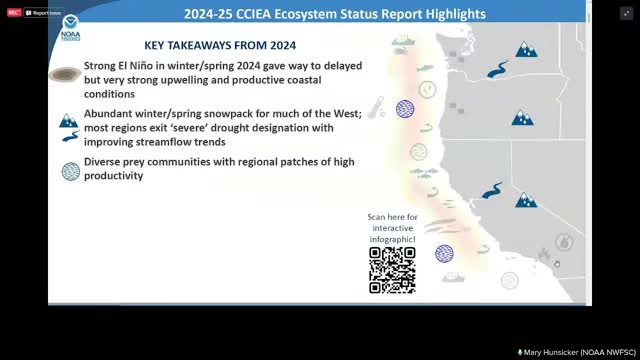California Current ecosystem faces diverse impacts from El Nino and harmful algal blooms
March 08, 2025 | Fishery Management Council, Pacific, Governor's Office - Boards & Commissions, Executive, Washington
This article was created by AI summarizing key points discussed. AI makes mistakes, so for full details and context, please refer to the video of the full meeting. Please report any errors so we can fix them. Report an error »

In a meeting filled with critical discussions about the health of marine ecosystems, the Pacific Fishery Management Council (PFMC) convened on March 7, 2025, to address the complex interplay of environmental factors affecting fisheries along the West Coast. The backdrop of the meeting was shaped by the lingering effects of a strong El Niño, which had significant implications for marine life and fishing communities.
As the meeting unfolded, experts highlighted the dual nature of the past year. On one hand, the winter and spring of 2024 saw a robust upwelling that fostered strong productivity along the coast, aided by abundant snowpack and improved streamflow in many regions. This upwelling led to a diverse and plentiful prey community, particularly benefiting species like juvenile anchovies and rockfish. However, the year was not without its challenges. A top ten marine heat wave, primarily offshore, and emerging drought conditions in late 2024 posed serious threats to marine life and fisheries. Notably, harmful algal blooms (HABs) impacted shellfish fisheries and human health, while the Chinook salmon fishery faced closures for a second consecutive year.
The discussions also revealed a concerning trend: an increase in humpback whale entanglements and declines in catches for several harvest groups, particularly Pacific whiting. Fishing communities in Oregon and Washington reported shifts in well-being metrics, underscoring the socio-economic impact of these environmental changes.
Despite these challenges, there were glimmers of hope. The meeting noted positive signals for the return of Chinook salmon to the Columbia Basin in 2025, alongside improved out-migration conditions for California salmon smolts. Revenue from fisheries, particularly the market squid and crab fisheries, saw a 3% increase from the previous year, providing a much-needed boost to local economies.
As the PFMC continues to navigate these complex issues, the insights shared during this meeting will be crucial in shaping future management strategies. The interplay of environmental conditions and their impact on marine ecosystems remains a pressing concern, one that will require ongoing attention and adaptive management to ensure the sustainability of fisheries and the communities that rely on them.
As the meeting unfolded, experts highlighted the dual nature of the past year. On one hand, the winter and spring of 2024 saw a robust upwelling that fostered strong productivity along the coast, aided by abundant snowpack and improved streamflow in many regions. This upwelling led to a diverse and plentiful prey community, particularly benefiting species like juvenile anchovies and rockfish. However, the year was not without its challenges. A top ten marine heat wave, primarily offshore, and emerging drought conditions in late 2024 posed serious threats to marine life and fisheries. Notably, harmful algal blooms (HABs) impacted shellfish fisheries and human health, while the Chinook salmon fishery faced closures for a second consecutive year.
The discussions also revealed a concerning trend: an increase in humpback whale entanglements and declines in catches for several harvest groups, particularly Pacific whiting. Fishing communities in Oregon and Washington reported shifts in well-being metrics, underscoring the socio-economic impact of these environmental changes.
Despite these challenges, there were glimmers of hope. The meeting noted positive signals for the return of Chinook salmon to the Columbia Basin in 2025, alongside improved out-migration conditions for California salmon smolts. Revenue from fisheries, particularly the market squid and crab fisheries, saw a 3% increase from the previous year, providing a much-needed boost to local economies.
As the PFMC continues to navigate these complex issues, the insights shared during this meeting will be crucial in shaping future management strategies. The interplay of environmental conditions and their impact on marine ecosystems remains a pressing concern, one that will require ongoing attention and adaptive management to ensure the sustainability of fisheries and the communities that rely on them.
View full meeting
This article is based on a recent meeting—watch the full video and explore the complete transcript for deeper insights into the discussion.
View full meeting
